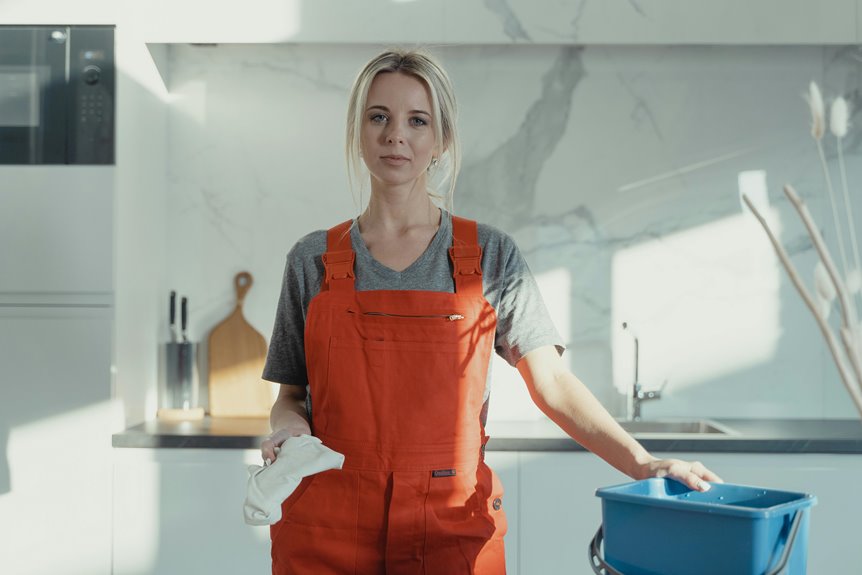I’ve learned that a truly organized home looks different from the spotless spaces we see on social media. After years of working towards an impossible standard, I now understand that a few dishes in the sink and scattered toys don’t signal disorder – they’re signs of a lived-in space that works for real people. Let me share what I’ve discovered about creating a home that’s clean enough to be comfortable while remaining practical for daily life.
The Reality Behind Social Media’s Clean Home Illusion

While scrolling through social media, I’m constantly bombarded with perfectly staged photos of immaculate homes, pristine countertops, and magazine-worthy living spaces that seem too good to be true.
Let me share a secret: those clean homes you see on social media aren’t real-life representations of daily living.
I’ve learned that most of those photos are carefully curated moments, often taken right after a deep clean or professional staging.
What you don’t see are the dishes in the sink, the unfolded laundry on the couch, or the toys scattered across the floor just outside the camera frame.
Understanding this reality has helped me set realistic expectations for my own home, where I focus on maintaining a safe, comfortable space rather than chasing an impossible standard of perfection.
Defining Your Personal Standard of “Clean Enough”
Instead of comparing ourselves to unrealistic social media standards, let’s focus on what “clean enough” means for our own homes and lifestyles.
I believe personal cleanliness comes down to what makes you feel comfortable and safe in your space. Your individual preferences matter more than someone else’s idea of perfection.
Maybe you’re okay with a few dishes in the sink but can’t stand dusty surfaces, or perhaps you need spotless counters but don’t mind an unfolded laundry basket.
I encourage you to think about which cleaning tasks truly impact your daily life and well-being. Start by identifying your non-negotiables – those things that must be clean for you to feel at peace.
Then, create realistic cleaning routines that align with your schedule, energy levels, and priorities.
Essential Daily Habits That Keep a Home Running
Three essential daily habits form the foundation of a well-maintained home: cleaning as you go, completing one load of laundry, and tidying before bed.
I’ve found that daily cleaning becomes much easier when I wipe counters after each meal, rinse dishes immediately, and sweep high-traffic areas like the kitchen and entryway.
Home organization flows naturally when I tackle one complete load of laundry – from washing to folding and putting away – which prevents overwhelming pileups.
Before heading to bed, I spend 10 minutes returning items to their designated spots, fluffing pillows, and clearing surfaces in the main living areas.
When you maintain these habits consistently, you’ll find your home stays manageable without requiring marathon cleaning sessions on weekends.
Strategic Storage Solutions for Real Life

Since organizing a home requires strategic storage solutions, I’ve developed practical systems that work for everyday life. My favorite storage hacks include using clear bins in pantries, installing hooks inside cabinet doors, and maximizing vertical space with adjustable shelving.
I’ve found that effective decluttering strategies start with designating specific zones for different categories, like creating a dedicated spot for incoming mail, kids’ school items, and seasonal decorations. When you establish these zones, you’ll naturally maintain order because everything has its place.
I recommend investing in dual-purpose furniture, such as ottomans with hidden storage or beds with drawers underneath. These solutions help you make the most of your space while keeping necessary items close at hand but neatly concealed.
Creating Systems That Actually Work for Your Family
While storage solutions provide the foundation for an organized home, creating personalized systems transforms those spaces into a functional reality for your family.
I’ve found that family involvement in designing and maintaining organizational systems guarantees everyone stays committed to keeping things tidy. When you create systems that match your family’s natural habits and routines, maintaining order becomes second nature.
- Create designated drop zones near entrances for shoes, bags, and daily essentials
- Set up morning routine stations in bathrooms and bedrooms with frequently used items
- Establish homework areas with supplies organized by subject and grade level
- Design meal planning systems with weekly menus and matching grocery lists
- Implement laundry schedules with personalized hampers and folding methods for each family member
Managing High-Traffic Areas and Common Clutter Zones
High-traffic areas and clutter zones can quickly derail your home’s organization, no matter how well-designed your storage systems may be.
I’ve found that entryway organization is essential since it’s where shoes, bags, and coats tend to pile up throughout the day. I recommend installing hooks at different heights, adding a bench with storage underneath, and using labeled bins for each family member.
The kitchen counter, dining table, and living room coffee table are common clutter magnets that I’ve learned to manage through daily reset routines.
For clutter management in these spaces, I designate specific spots for mail, school papers, and frequently used items. I also keep decorative trays and baskets nearby to contain loose items until they can be properly sorted and put away.
Simple Routines That Prevent Mess Buildup

Creating daily routines is the cornerstone of maintaining a clutter-free home that stays organized without overwhelming effort.
I’ve found that simple habits, when practiced consistently, prevent the kind of mess that makes cleaning feel like a massive undertaking. By following cleaning checklists and committing to daily decluttering, I keep my home manageable with minimal stress.
- Make my bed immediately after waking up to set a productive tone for the day
- Wipe kitchen counters and sinks after each meal to prevent grime buildup
- Sort mail and papers as soon as they enter the house, recycling junk immediately
- Put items away right after use instead of creating “I’ll do it later” piles
- Complete a 10-minute evening reset of main living spaces before bedtime
Breaking Free From Perfectionist Cleaning Standards
Perfectionist cleaning standards can hold us back from maintaining a consistently tidy home.
I’ve learned that breaking free from a perfectionist mindset starts with accepting that a lived-in house doesn’t need to look like a magazine spread.
I recommend setting realistic expectations by focusing on function over pristine appearances.
Your kitchen counter might’ve a coffee maker and toaster visible, and that’s perfectly fine.
When implementing decluttering strategies, I suggest starting with small, achievable goals rather than attempting complete room transformations.







